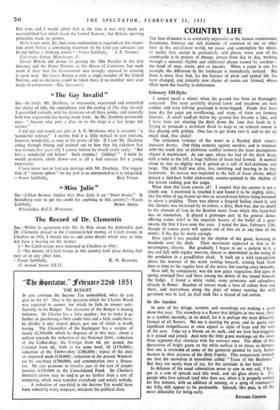February Fill-Dyke
I cannot recall a winter when the ground has been so thoroughly saturated. The most carefully drained lawns and meadows are now sodden, and even hill-top grassland is water-logged. Ponds that have been dry for years are overflowing, and many of them are forming binaries. A small sand-pit below my ground has become a lake, and 1 have been out clearing the ditch down the lane that leads to it. Trying to persuade a turbulent flood to keep to an ordered course is like playing with politics. One has to get down into it, and to stir up much mud, that sticks!
The miniature violence of the water in a flooded ditch creates incessant drama. One thing cannons against another, and is resented, with. the result that an elaborate conflict between the most incongruous objects is maintained. At one spot, where the bed of the ditch drops with a twist to the left, .a huge balloon of foam had formed. It seemed about to rise, so slightly was it poised on a raft of leaf-skeletons and twigs. The raft itself was alive, too, twitching and heaving in its tiny backwater. Its motion was imparted to the ball of foam above, which danced a tied-foot ballet elaborately counter-pointed to the rhythm of the stream rushing past the coign.
What does this foam consist of? I suspect that the answer is not a simple one. I examined it, touched it and found it to be slightly sticky, like the white of egg beaten up into an aerated mass before being browned to adorn a pudding. There was almost a fungoid feeling about it, and this likeness was increased by its colour, a dirty, flesh hue, due no doubt- to the element of iron in the Kentish water from which this foam-ball was an emanation. It played a grotesque part in the general dance, offering comic relief to the exquisite beauty of the ballet of a gnat- swarm, the first I have seen this year. I noted the date, February 12th, though of course gnats will appear out of thin air at any time of the winter, if the day be warm enough.
Here again I was puzzled by the rhythm of the gnats, hovering in hundreds over the ditch. Their movement appeared at first to be meaningless, chaotic. But gradually I began to see a pattern in it, a rise and fall, with regular swerves, almost as determined as the swing of the pendulum in a grandfather clock. It built up a wild syncopation above the murmur of the water rushing beneath, coming back from time to time to the regular beat of the metre, but soaring away instantly. How still, by comparison, was the new green vegetation, first signs of spring, emerged here and there among the debris of the runnel beneath the hedge. I found a white violet, some primroses and celandines already in flower. Bunches of tresses made a boss of colour here and there, and everywhere along the plats of winter matting the wild geranium was in leaf, its frail stalk like a thread of red cotton.






































 Previous page
Previous page